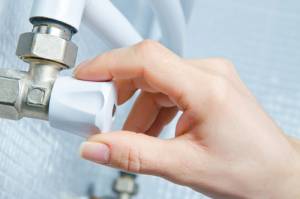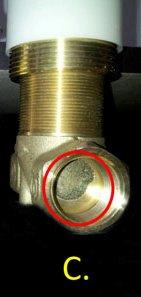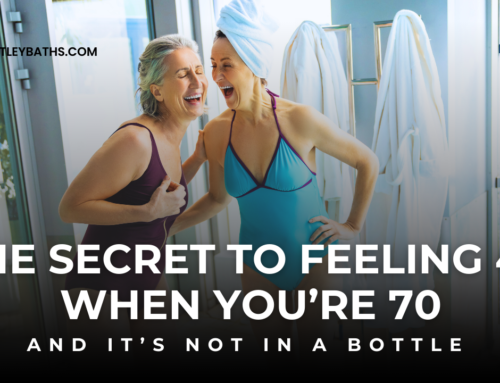In this blog I discuss how we can avoid the second-worst cause of injuries in the bathroom, those related to the temperature of the water we use every day.
Water Temperature Related Injuries
The second-worst cause of injuries around the bathtub and shower is unsafe water temperature. This is what is referred to as the phenomenon of “shock and scald.” Shock is caused by cold water. Because of the sudden discomfort, the bather instinctively moves quickly to adjust the water temperature or leaves the tub. Scalding is caused by dangerously hot water and can cause burns.
The Americans with Disabilities Act is a really good guideline for these situations. It tells us that we should not be putting water or anything into the bathing environment that exceeds 110 degrees. However, most domestic water heating systems in the United States will store their water between 120 and 160 degrees.
At 110 to 112 degrees, it will take at least twenty-five minutes before that water can cause any skin injury. If we raise that water temperature to 120 degrees, the burn time is decreased to about 19 seconds. Increase the water temperature to 140 degrees and burn time decreases to twelve seconds, and at 150 degrees it’s basically less than one second.
But Water Has to Be Hot!
 There’s a competing problem when it comes to heating water. We should be storing our domestic hot water at higher temperatures than most do. At 120 degrees, we may save a few dollars every year in energy costs, but we actually expose ourselves to higher risk of bacterial infections.
There’s a competing problem when it comes to heating water. We should be storing our domestic hot water at higher temperatures than most do. At 120 degrees, we may save a few dollars every year in energy costs, but we actually expose ourselves to higher risk of bacterial infections.
According to the Center for Disease Control, water stored at less than 150 degrees will permit the growth of numerous bacteria that can cause us illness. A number of the colds, flu, runny noses and little illnesses we experience over the course of a year may in fact be caused by bacteria that’s allowed to grow in our domestic hot water. We all remember the Legionnaire’s Disease event of years ago. This occurrence happened because water was being stored in hotels and on cruise ships below 150 degrees and thus the Legionella bacteria was able to thrive in their domestic hot water systems. Many, many people were infected and a large number died. As a result, all cruise ships, hotels and public buildings that serve large populations of people will store their water at 150 degrees, because this is the temperature at which the Legionella bacteria cannot survive.
So here are some interesting statistics on hot water:
–131 degrees is the temperature in degrees Fahrenheit that is required to kill the Legionella bacteria in a water heater. This temperature must be maintained at all times to keep the water safe.
–Every year in the United States, there are between 3,000 and 4,000 cases of water-related scalds. There is approximately a 30% death rate for those over the age of 60 who experience these scald-related injuries.
–The average water temperature that creates the sensation of pain is 106 degrees. If you factor in the fact that most hot tubs are maintained at 104 to 106 degrees, you can understand why it is so difficult and dangerous for many, especially seniors, to even enter one of these bathing appliances. Pain is felt at 106 degrees, so it is extremely important that our water control processes are effective. It is extremely easy for us to create a situation in which the water entering the bathing environment is hot enough to create pain, resulting in the cycle of shock and scald in order to avoid this painful situation. This is very, very dangerous.
–More than 90% of scalding incidents occur in our home. Young children are particularly at risk because of their tender skin, but the slow reaction time of seniors and those with disabilities make them the most vulnerable to serious hot water burns. Scalding injuries are tremendously painful and the effects can last for years.
Scalding occurs for a variety of reasons. In some cases, water heater thermostats are faulty or set too high, and in others, temperature-regulating valves for the domestic hot water source are either malfunctioning or missing.
The Secret Is Control
 How can these problems be resolved? How do we protect ourselves? The answer is the same no matter at what temperature you store your domestic water. We must have sufficient and appropriate temperature control valves installed in all our bathtubs and showers. This is in fact a guideline of the Americans with Disabilities Act.
How can these problems be resolved? How do we protect ourselves? The answer is the same no matter at what temperature you store your domestic water. We must have sufficient and appropriate temperature control valves installed in all our bathtubs and showers. This is in fact a guideline of the Americans with Disabilities Act.
The issue manifests because we have any number of situations were a bather may accidentally or unknowingly permit water that is too hot or too cold to enter the bathtub. This discomfort makes us move quickly to resolve the problem and therefore exponentially increases our risk of injury. The fact that we are in an individual bathing appliance, and we are not free to move about with ease, increases the risk that our skin will remain in contact with the water long enough to suffer a burn.
Finally, most people shower at a significantly lower water temperature than they bathe. This means our standard approach to plumbing bathtubs and showers in the United States, using a diverter to divert the tub flow to the shower system, sets up a very high risk of injury. If I adjust the water temperature flowing into the tub to what feels to me to be appropriate and I divert that to the shower, I’m at a very high risk of that water being too hot for me, and therefore needing to adjust the temperature to stay in the shower.
If the impact of the scalding water or shocking water does not cause me to fall immediately, I am forced to try to make my way back to the valves to adjust them or turn them off in order to stop the flow. This is extremely unsafe for an 18-year-old, and life-threatening for an 80-year-old. Anything that decreases our focus on being stable and balanced in the bathing environment is a significant factor in increasing our risk of injury.
So what is the answer? According to the Americans with Disabilities Act, every source of water within the bathing environment should have its own anti-scald protection. This means that the tub filler and/or shower should be protected from excessively hot water entering the bathing environment. There are a number of technologies that address this issue, but the bottom line is every single bathtub should be modified to include the installation of an appropriate anti-scald valve.
Type P vs. Type T
 Most anti-scald valves in the United States are what are called “Type P” thermostatic mixing valves. These are very common in hardware stores and plumbing stores throughout the United States. The “P” refers to the function of a pressure balance between the hot and the cold that is designed into the valve. This is a mechanical process whereby a reduction or increase in the pressure from either the hot or the cold will generate a mechanism to stabilize or balance the pressure between the hot and the cold.
Most anti-scald valves in the United States are what are called “Type P” thermostatic mixing valves. These are very common in hardware stores and plumbing stores throughout the United States. The “P” refers to the function of a pressure balance between the hot and the cold that is designed into the valve. This is a mechanical process whereby a reduction or increase in the pressure from either the hot or the cold will generate a mechanism to stabilize or balance the pressure between the hot and the cold.
The bottom line for our purposes is that these valves are far better than nothing, but also far from perfect. Pressure balance valves that we commonly use in the United States can have a temperature fluctuation that ranges between five and fifteen degrees, depending on the circumstances.
What this means is that if you set the temperature on the valve at a comfortable level and begin the bathing process, if there is a drop in the pressure, the adjustment can create a fluctuation that could range pretty significantly in terms of the water temperature being delivered to the bather.
If someone flushes a toilet, the cold side of the flow to the bath could lose pressure significantly. If the temperature fluctuates significantly, it can still generate uncomfortable and therefore potentially dangerous water temperatures for a senior bather. But again, this technology is far, far superior to no anti-scald valve at all.
By far the best technology is what is referred to as a “Type T” anti-scald valve. These mixing valves are true “thermostatic” valves. That is what the “T” stands for.
A true thermostatic valve physically shuts down the flow of water to the fixture if the mixed temperature exceeds a predetermined level. This approach is the ultimate fail-safe enabling protection within the bathing environment. Accordingly, we recommend that every source of water in a bathtub or shower be protected by a true “Type T” thermostatic mixing valve that is sized properly for the appropriate flow.
Stay tuned for the next installment of the Bentley Baths blog, in which I detail the injuries that can result from poorly located bathroom controls and what to do about them.









